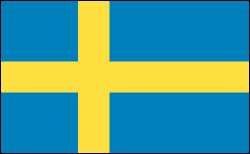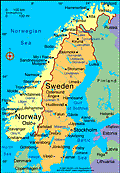Sweden | Facts & Information

- Sweden Profile
- History
- News and Current Events
Facts & Figures
-
Sovereign: King Carl XVI Gustaf (1973)
Prime Minister: Stefan Löfven (2014)
Land area: 158,927 sq mi (411,621 sq km); total area: 173,731 sq mi (449,964 sq km)
Population (2014 est.): 9,723,809 (growth rate: 0.79%); birth rate: 11.92/1000; infant mortality rate: 2.6/1000; life expectancy: 81.89; density per sq mi: 55.6
Capital and largest city (2014 est.): Stockholm, 1.372 million
Other large cities (2014 est.): Göteborg, 536,790; Malmö, 303,873
Monetary unit: Krona
National name: Konungariket Sverige
Language: Swedish, small Sami- and Finnish-speaking minorities
Ethnicity/race: indigenous population: Swedes with Finnish and Sami minorities; foreign-born or first-generation immigrants: Finns, Yugoslavs, Danes, Norwegians, Greeks, Turks
Religions: Lutheran 87%, other (includes Roman Catholic, Orthodox, Baptist, Muslim, Jewish, and Buddhist) 13%
Literacy rate: 99% (2003 est.)
Economic summary: GDP/PPP (2013 est.): $393.8 billion; per capita $40,900. Real growth rate: 0.9%. Inflation: 0%. Unemployment: 8.1%. Arable land: 5.8% (2011). Agriculture: barley, wheat, sugar beets; meat, milk. Labor force: 5.107 million; agriculture 1.1%, industry 28.2%, services 70.7% (2013 est.). Industries: iron and steel, precision equipment (bearings, radio and telephone parts, armaments), wood pulp and paper products, processed foods, motor vehicles. Natural resources: iron ore, copper, lead, zinc, gold, silver, tungsten, uranium, arsenic, feldspar, timber, hydropower. Exports: $181.5 billion (2013 est.): machinery 35%, motor vehicles, paper products, pulp and wood, iron and steel products, chemicals. Imports: $158 billion (2013 est.): machinery, petroleum and petroleum products, chemicals, motor vehicles, iron and steel; foodstuffs, clothing. Major trading partners: U.S., Germany, Norway, UK, Denmark, Finland, France, Netherlands, Belgium, Russia, China (2012).
Communications: Telephones: main lines in use: 4.321 million (2012); mobile cellular: 11.643 million (2012). Radio broadcast stations: AM 1, FM 265, shortwave 1 (2008). Radios: 8.25 million (1997). Television broadcast stations: 169 (plus 1,299 repeaters) (1995). Televisions: 4.6 million (1997). Internet Service Providers (ISPs): 5.978 million (2010). Internet users: 8.398 million (2009).
Transportation: Railways: total: 11,633 km (2008). Highways: total: 579,564 km; (including 1,913 km of expressways); (2010). Waterways: 2,052 km navigable for small steamers and barges (2010). Ports and harbors: Brofjorden, Goteborg, Helsingborg, Karlshamn, Lulea, Malmo, Stockholm, Trelleborg, Visby. Airports: 231 (2013).
International disputes: none.









